1995 PONTIAC GRAND-AM seats
[x] Cancel search: seatsPage 2 of 354
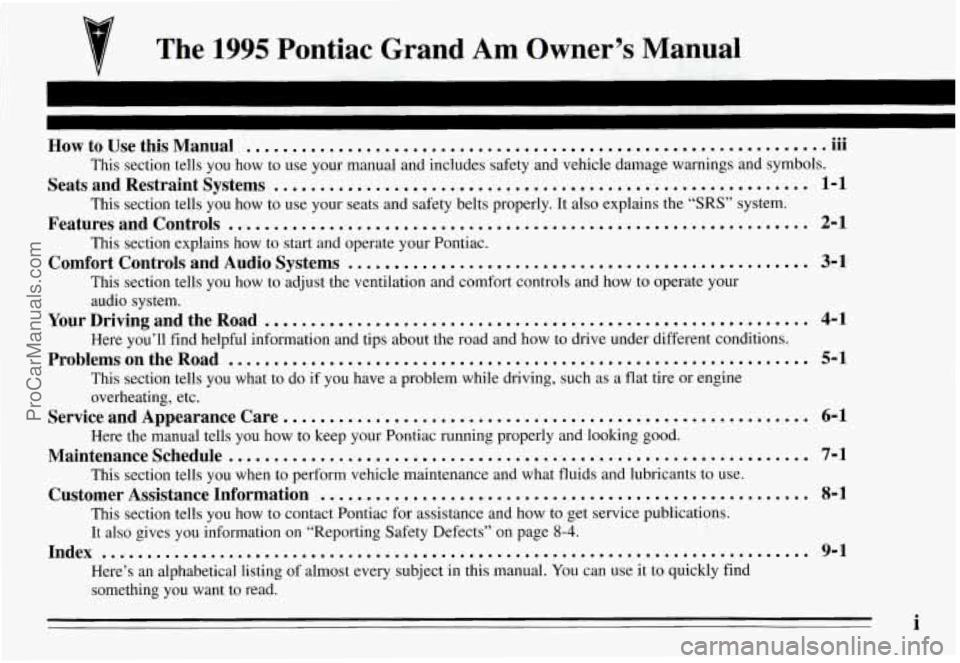
v The 1995 Pontiac Grand Am Owner’s Manual
... How to Use this Manual .............................................................. .111
Seats and Restraint Systems .......................................................... 1-1
Features and Controls ............................................................... 2-1
Comfort Controls and Audio Systems .................................................. 3-1
This section tells you how to use your manual and includes safety and vehicle damage warnings and symbols.
This section tells you how to use your seats and safety belts properly. It also explains the “SRS” system.
This section explains how to start and operate your Pontiac.
This section tells you how to adjust the ventilation and comfo\
rt controls and how to operate your
audio system.
Here you’ll find helpful information and tips about the road\
and how
to drive under different conditions.
This section tells you what to do
if you have a problem while driving, such as a flat tire or engine
overheating, etc.
Here the manual tells you how to keep your Pontiac running properly and looking good.
This section tells you when to perform vehicle maintenance and what fluids and lubricants to use.
This section tells you how to contact Pontiac for assistance and how to get service publications.
It also gives you information on “Reporting Safety Defects” on page 8-4.
Here’s an alphabetical listing of almost every subject in this manual. You can use it to quickly find
something you want to read.
YourDrivingandtheRoad ........................................................... 4-1
ProblemsontheRoad ............................................................... 5-1
Service and Appearance Care. ........................................................ 6-1
Maintenanceschedule ............................................................... 7-1
Customer Assistance Information ..................................................... 8-1
Index ........................................................................\
..... 9-1
i
ProCarManuals.com
Page 8 of 354

Section 1 Seats and Restraint Systems
Here you’ll find information about the seats in your
Pontiac and how to use your safety belts properly. You
can also learn about some things you should not do with
air bags and safety belts.
Seats and Seat Controls
This section tells you about the seats -- how to adjust them
-- and also about reclining seatbacks and head restraints.
Manual Front Seat
Move the control lever under the front of the seat to
unlock it. Slide the seat to where you want it. Then
release the lever and try
to move the seat with your
body, to make sure the seat is locked into place.
1-1
ProCarManuals.com
Page 12 of 354
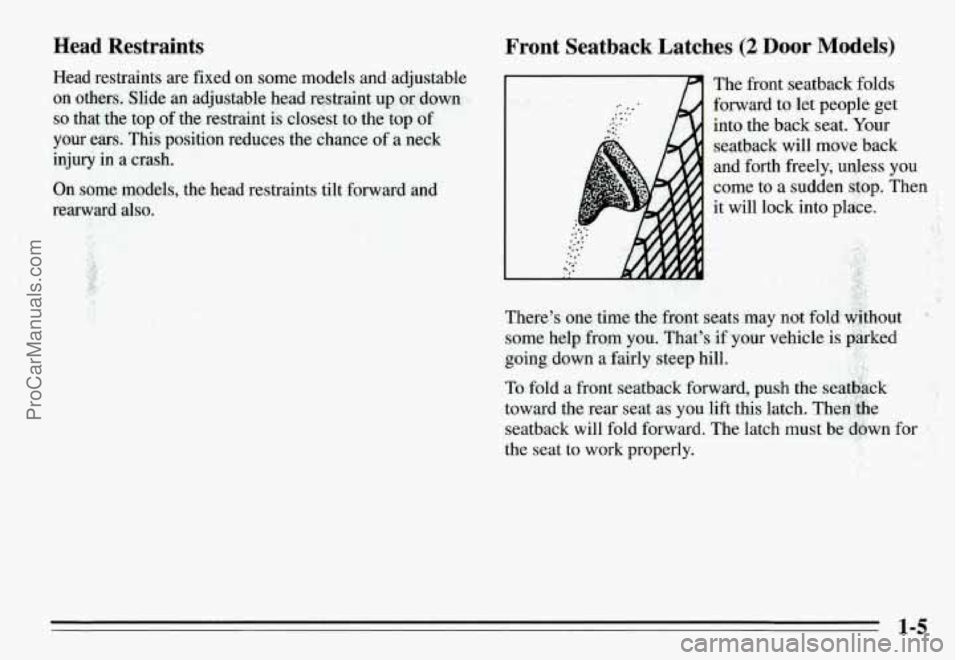
Head Restraints
Head restraints are fixed on some models and adjustable
on others. Slide
an adjustable head restraint up or down
so that the top of the restraint is closest to the top of
your ears. This position reduces the chance of a neck
injury in a crash.
On some models, the head restraints tilt forward and
rearward also.
Front Seatback Latches (2 Door Models)
The front seatback folds
forward
to let people get
into the back seat.
Your
seatback will move back
and forth freely, unless you
come to a sudden stop. Then
it will lock into place.
There’s one time the front seats may not fold without ‘
some help from you. That’s if your vehicle is parked
going down a fairly steep hill.
To fold a front seatback forward, push the seatbgck
toward the rear seat as you lift this latch. Then the
seatback will fold forward. The latch must be dswn for
the seat to work properly.
ProCarManuals.com
Page 20 of 354
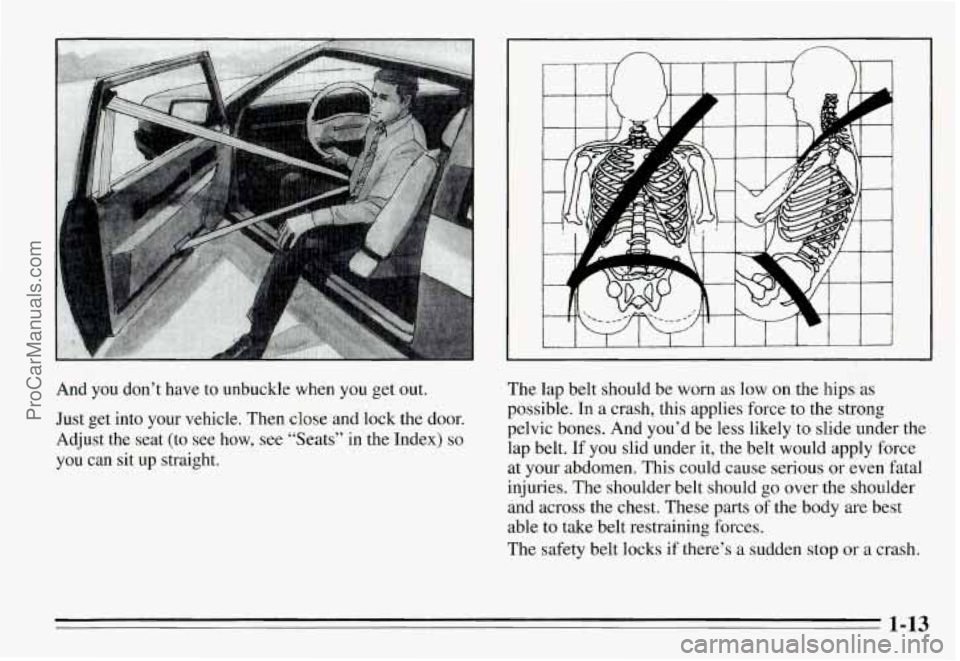
And you don’t have to unbuckle when you get out.
Just get into your vehicle. Then close and lock the door.
Adjust the seat (to see how, see “Seats’’ in the Index)
so
you can sit up straight.
The lap belt should be worn as low on the hips as
possible. In a crash, this applies force to the strong
pelvic bones. And you’d be less likely
to slide under the
lap belt.
If you slid under it, the belt would apply force
at your abdomen. This could cause serious
or even fatal
injuries. The shoulder belt should
go over the shoulder
and across the chest. These parts of the body are best
able to take belt restraining forces.
The safety belt locks
if there’s a sudden stop or a crash.
1-13
ProCarManuals.com
Page 21 of 354
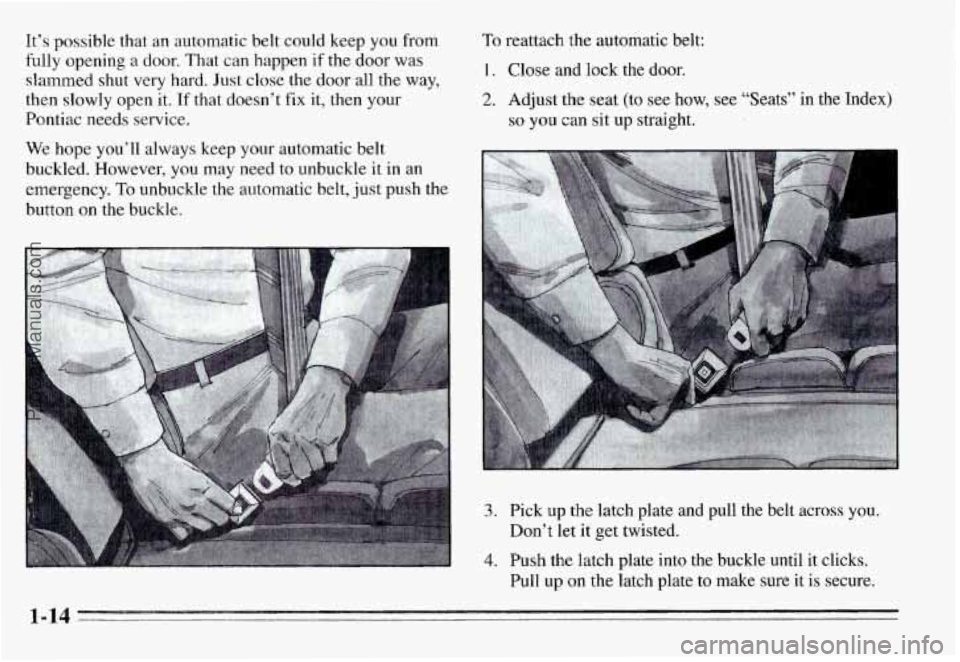
It’s possible that an automatic belt could keep you from
fully opening a door. That can happen
if the door was
slammed shut very hard. Just close the door all the way,
then slowly open it.
If that doesn’t fix it, then your
Pontiac needs service.
We hope you’ll always keep your automatic belt
buckled. However, you may need to unbuckle it in an
emergency.
To unbuckle the automatic belt, just push the
button
on the buckle.
To reattach the automatic belt:
1. Close and lock the door.
2. Adjust the seat (to see how, see “Seats” in the Index)
so you can sit up straight.
- I
3. Pick up the latch plate and pull the belt across you.
Don’t let it get twisted.
4. Push the latch plate into the buckle until it clicks.
Pull up on the latch plate to make sure it is secure.
1-14
ProCarManuals.com
Page 31 of 354
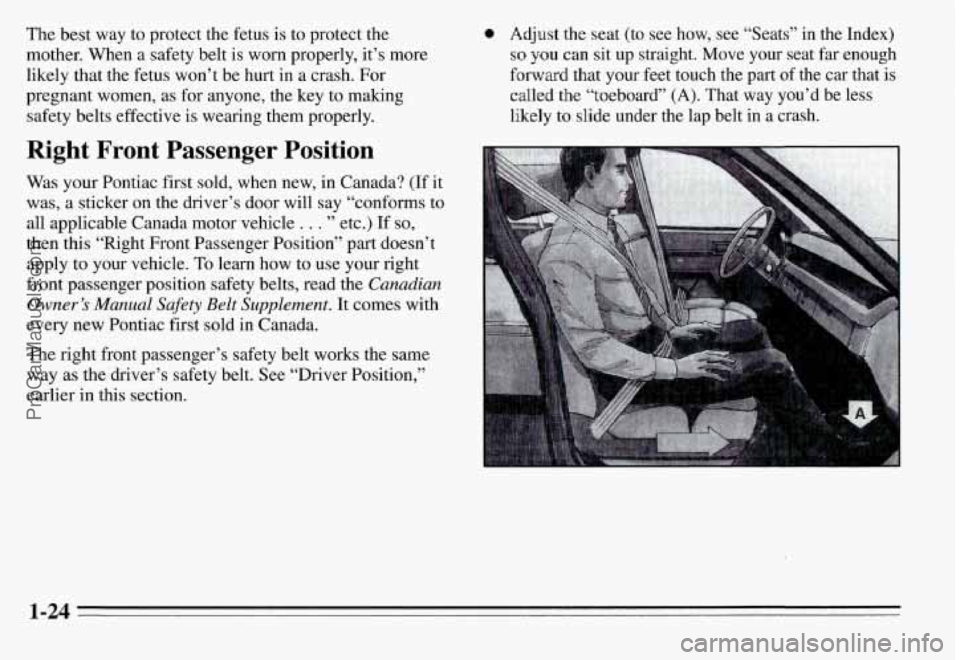
The best way to protect the fetus is to protect the
mother. When a safety belt is worn properly, it’s more
likely that the fetus won’t be hurt in a crash. For
pregnant women, as for anyone, the key to making
safety belts effective is wearing them properly.
Right Front Passenger Position
Was your Pontiac first sold, when new, in Canada? (If it
was, a sticker on the driver’s door will say “conforms to
all applicable Canada motor vehicle
. . . ” etc.) If so,
then this ‘‘Right Front Passenger Position” part doesn’t
apply to your vehicle. To learn how to
use your right
front passenger position safety belts, read the
Canadian
Owner’s Manual Safety Belt Supplement. It comes with
every new Pontiac fist sold in Canada.
The right front passenger’s safety belt works the same
way as the driver’s safety belt. See “Driver Position,”
earlier in this section.
0 Adjust the seat (to see how, see “Seats” in the Index)
so you can sit up straight. Move your seat far enough
forward that your feet touch the
part of the car that is
called the “toeboard” (A). That way you’d be less
likely to slide under the lap belt in a crash.
1-24
ProCarManuals.com
Page 72 of 354
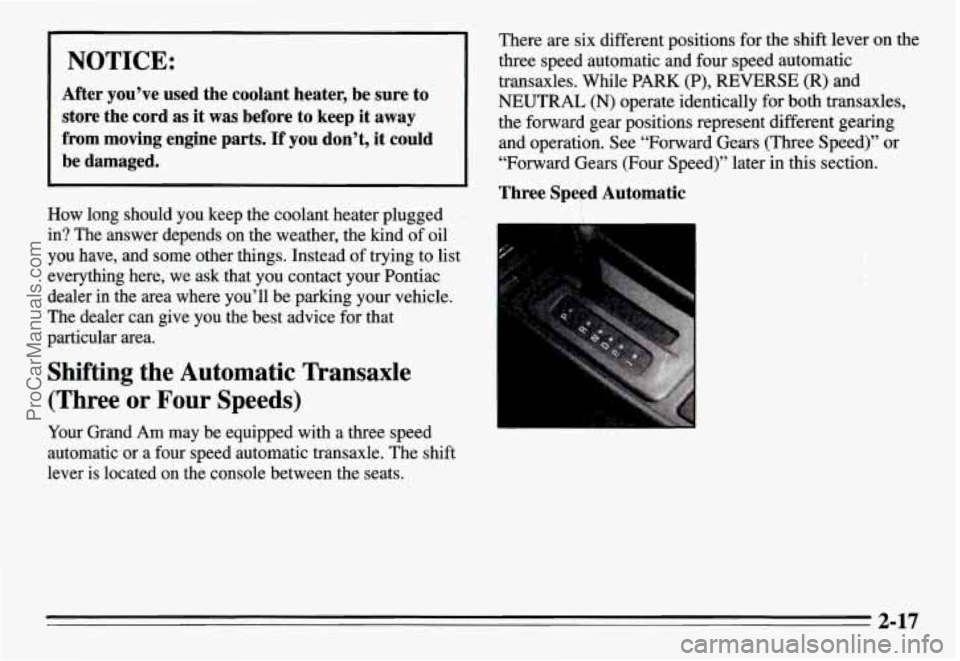
I NOTICE: I
After you’ve used the coolant heater, be sure to
store the cord as it was before to keep it away
from moving engine parts.
If you don’t, it could
be damaged.
How long should you keep the coolant heater plugged
in? The answer depends on the weather, the kind of oil
you have, and some other things. Instead of trying to list
everything here, we ask that you contact your Pontiac
dealer
in the area where you’ll be parking your vehicle.
The dealer can give you the best advice for that
particular area.
Shifting the Automatic Transaxle
(Three or Four Speeds)
Your Grand Am may be equipped with a three speed
automatic or a four speed automatic transaxle. The shift
lever
is located on the console between the seats.
There are six different positions for the shift lever on the
three speed automatic and four speed automatic
transaxles. While
PARK (P), REVERSE (R) and
NEUTRAL (N) operate identically for both transaxles,
the forward gear positions represent different gearing
and operation. See “Forward Gears (Three Speed)” or
“Forward Gears (Four Speed)’’ later in this section.
Three SpeFd Automatic
1.
.. . ..b
2-17
ProCarManuals.com
Page 127 of 354

Rear Window Defogger (Option)
The rear window defogger
uses a warming grid to
remove fog from the rear
window.
Press the defogger
switch. The indicator light
will glow. If your vehicle is
traveling under
45 mph
(70 km/h), the rear window
defogger will
turn off
automatically after about
10 minutes of use.
If your vehicle is traveling over 45 mph (70 km/h), the
defogger will operate continuously. You can
h’rm the defogger
off by turning off the ignition or pressing the switch again.
Do not attach a temporary vehicle license across the
defogger grid on the rear window.
I NOTICE:
Don’t use a razor blade or something else sharp
on the inside
of the rear window. If you do, you
could cut or damage the warming grid, and the
repairs wouldn’t be covered by your warranty.
Flow-Through Ventilation System
Your Pontiac’s flow-through ventilation system supplies
outside air into the vehicle when it
is moving. Outside
air will also enter the vehicle when the heater or the air
conditioning fan
is running.
Ventilation Tips
0
0
0
Keep the hood and front air inlet free of ice, snow, or
any other obstruction (such as leaves). The heater
and defroster will work far better, reducing the
chance of fogging the inside of your windows.
When you enter a vehicle in cold weather, turn the
fan control
knob to the highest position for a few
moments before driving
off. This helps clear the
intake ducts of
snow and moisture, and reduces the
chance of fogging the inside of your windows.
Keep the air path under the front seats clear of
objects. This helps air to circulate throughout your
vehicle.
3-4
ProCarManuals.com